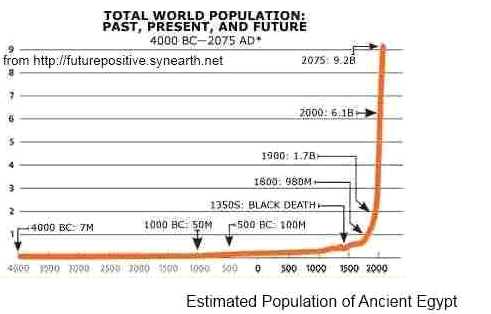

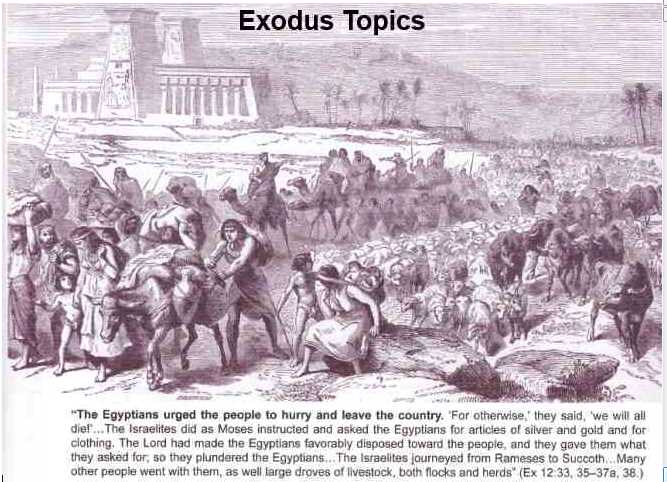
contents
Chapter 1 ... Exodus Population
Chapter 2 ... The Mystery of the Exodus Route
Chapter 3 ... Were the Israelites in Egypt for 210 years or 430 years ??
Deu 7:1 When Jehovah your God shall bring you into the land where you go to possess it, and has cast out many nations before you, the Hittites, and the Girgashites, and the Amorites, and the Canaanites, and the Perizzites, and the Hivites, and the Jebusites, seven nations greater and mightier than you,
Deu 7:7 Jehovah did not set His love upon you, nor choose you, because you were more in number than any people, for you were the fewest of all people.
Deu 11:23 then Jehovah will drive out all these nations from before you, and you shall possess greater and mightier nations than you.
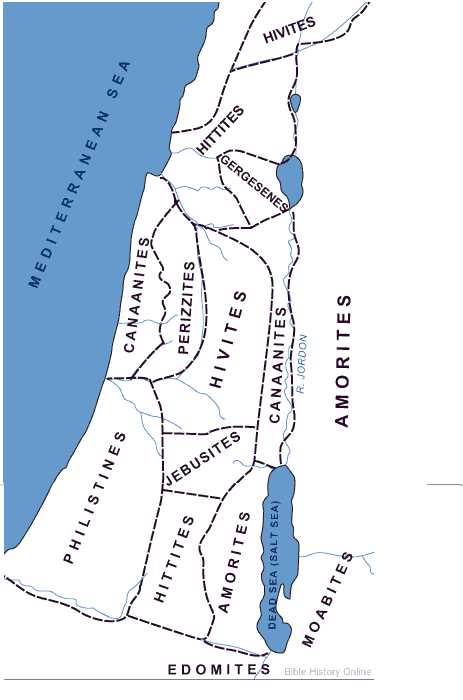
It is easy to understand that they were fewer than the Hitites, for they occupied considerable territory. Or even the Amorites, but how about even the Perizzites and the Jebusites, for their territories were very small ! Each less than 1000 square miles. For them to have over 2 million population would require a density of over 2000 people per square mile and the present density of modern Israel is less than 1000 per square mile !!
Those that study ancient populations estimate that the world population was about 40 million at the time of the Exodus and with 3 million Egyptians give or take a million.


They also estimate that the population of ancient Israel was probably about 300,000 at its maximum in the time of David. This is based on estimates of about 10,000 for capital cities like Jerusalem and Samaria, 2000-3000 for regional centers like Dan, Megiddo and Beersheba, and 500-1000 for small country towns or villages.
Many have estimated that the population of the Exodus was between 2 to 3 million, which could be as many as one half of the population of Egypt at the time ! Does this seem realistic considering the preceding information ?? No !! For they seem to be forgetting that the Scriptures repeatedly emphasizes that Israel was smaller than the nations of the territory they were to occupy. As shown Deut. 7:1 lists the seven nations that were greater than they were, and v. 7 says they were the fewest of all the peoples (see also Deut. 9:1, 11:23, and 20:1). This is consistent with the fearful report of the spies in Num. 13. But, these nations were almost certainly not greater in population than two million each. Example, two to three million times 7 for the nations listed as being more numerous and this would be more than 14 to 21 million people or up to half of the estimated world population of 40 million at that time. In an area which even today has only about 15 million population with Israel and Jordan combined!!
Here are the figures from the most popular translations of the applicable Scriptures. The population of Israel is reported in two different censuses during the time of the exodus in Numbers 1 and Numbers 26. In both censuses the men from age twenty and upward were said to be counted by tribe, but the tribe of Levi was not included.
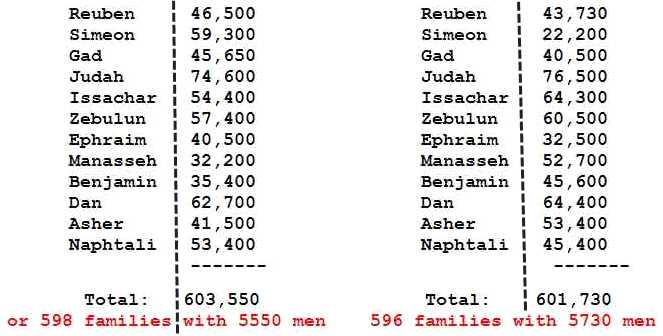
Below the totals above is illustrated another way of translating the results of the censuses. The most frequently suggested alternate is that the Hebrew word translated as "thousand" in these population figures actually refers to an indeterminate-size clan, troop or family. The Hebrew word itself is transliterated 'elep (Strong's number 505 or 504) and also carries the meaning of a family complex or clan in some cases, such as family (KJV)(ASV)(RV)(NAB)(LITV) and clan (AAT)(GNB)(CEV) in Judges 6:15. Also translates in Numbers 1:16 as family (BER), clans (AAT) (ESV) and troops (NAB). And also in I Samuel 10:19 translated as families (LITV)(CEV)(GW), clans (JERUS) and in I Samuel 23:23 clans (CEV)(JERUS), families (GW), divisions (MOF), and multitudes (KNOX).
Decoding the Census Numbers:
Numbers 1:2-3 (ESV) gives the instructions:
"Take a census of all the congregation of the people of Israel,
(a) by clans (tribe),
(b) by fathers' houses (household, families),
(c) according to the number of names, every male, head by head.
From twenty years old and upward,
all in Israel who are able to go to war,
you and Aaron shall list them, company by company."
Numbers 1:18 (ESV) again tells us when and how the census was conducted:
"and on the first day of the second month,
they assembled the whole congregation together,
who registered themselves (they declared their pedigrees according to their families)
(a) by clans (tribe),
(b) by fathers' houses (household, families),
(c) according to the number of names from twenty years old and upward, head by head, "
Therefore, we should expect the census data to contain the following information;
(a) tribe,
(b) family,
(c) number
for every male older than twenty who is able to fight !!
Using Reuben, the first born as the example ;
Num 1:20 (LITV) And the sons of
(a) Reuben, Israel's first-born,
(b) their generations by their families, by their fathers' house,
(c) in the number of names, by their heads, every male from a son of twenty years and upward, everyone able to go out to war:
Num 1:21 those numbered of them for the
(a) tribe of Reuben were
(b) forty six families and
(c) five hundred (men).
So What is the Total Population Implied by the Alternate Translations ?
The results for the first census adds up to 598 families or troops consisting of a total of 5550 men and the results for the second census is nearly the same at 596 families or troops consisting of 5730 men. This could possibly put the total population including women and children at somewhere between 20,000 to 40,000 and also much more in alignment with they being the less numerous of all the nations in the area !!
The population total resulting could seem to be low on the basis of the Scriptural reports of the number of people killed in various events during the time of the journey. For example, Num. 16:49 tells of a plague that killed 14,700, and Num. 25:9 tells of another plague killing 24,000. In the New Testament, 1 Cor. 10:8 tells of 23,000 being killed in one day, presumably in the incident of the golden calf. (The total number who died at this time is not recorded in the Old Testament.) Thus these three events account for more than 50,000 deaths, which seems quite large if the total population was only about 20,000 to 40,000. However, this does not mean that this view is impossible. In the first place, the 23,000 killed in the incident of the golden calf was before the first census was taken. It is possible that the original population was around 40,000 or more, and only around 20,000 to 30,000 were left for the first census. The population could have increased during the first part of the 40 years of wandering, only to be reduced again by the aforementioned plagues. Also note that they were accompanied in the exodus by a mixed multitude of unspecified size (Ex. 12:38). It is possible that the death tolls recorded included a significant portion from among this mixed multitude who were not included in the census.
The other possible explanation is that the individuals counted in the censuses were men who were not part of any clan. Thus, the first census would add up to 598 clans of unspecified size and 5550 additional men. Then the actual number of men would be left unspecified. This may be a legitimate alternative, but it certainly seems like a strange way to conduct a census, especially in light of the Scriptural description of the process as "Lift the heads of all the congregation of the sons of Israel, by their families, by their fathers' houses, according to the number of names, every male, by their heads;" (Num. 1:2 LITV). So this method is not considered!
Further Advantages of this View !
The assumption that Israel's population during the exodus was only around 20,000 to 40,000 instead of two million or more greatly simplifies the explanation of a number of difficult Scriptures. Some of them are discussed below:
The account of the conquest of Jericho would be hard to explain from a logistical point of view if the army of Israel numbered 600,000. Jos 6:3 "And you shall go around the city, all the men of war." The city would have been totally surrounded by the 600,000 men, unless it were many miles in circumference. But if it was that big, then how could the men march around it 7 times in one day? This problem is even more significant if we accept the archaeological findings that the walls of Jericho encompassed an area of only about 8½ acres, per research cited in The New Unger's Bible Dictionary (Moody, 1966, p. 672). Or less than a one mile walk depending upon how far they stayed away from the walls of the city. This is a much more reasonable fit for around 6000 to 10,000 men than 600,000.
In numerous places, Scripture speaks of the whole congregation of Israel listening to Moses or Aaron (e.g., Ex. 16:10, 35:1, Lev. 19:2, Num. 20:8, cf. Josh. 8:35), or gazing at Moses (Ex. 33:8), or assembling at the doorway of the tent of meeting (Num. 16:19). This is hard to fathom for a population of around two million, but probably plausible for a population of around 20,000 to 40,000.
In the incident of the golden calf, Moses instructed every man of the Levites to execute God's vengeance with the sword (Ex. 32:27). This they faithfully did (Ex. 32:28-29), and they ended up killing a total of 3000 people. If the tribe of Levi consisted of tens of thousands of men of fighting age, this seems like a rather small total assuming "every man" of them really did as he was told. But if the tribe of Levi consisted of only a few hundred men of fighting age to begin with, then it makes reasonable sense.
In Num. 20:17, Israel requested permission of the Edomites to travel through their land, promising to stay on a certain highway. The same request is made to the Amorites in Num. 21:22. If the population of Israel was around two million, how could they possibly travel through on a single highway, along with all their possessions? Even if they could go 10 abreast with only 10 feet between groups, the line would stretch out for nearly 400 miles! This would be a difficult enough task even for a population of only around 20,000 to 40,000. It seems utterly inconceivable for a population of around two million.
Conclusion:
We have presented the best estimates of those that study ancient populations, and shown an alternate interpretation of the populations of the exodus, and illustrated how these much smaller estimates of around 20,000 to 40,000 are more in line with they being "the fewest of all people". Also provided a number of other verses that give clues for a much smaller population than the estimate of 2 million or more made by many well meaning scholars.
Strong's Hebrew Dictionary definitions for #504 and #505
from Strong's Hebrew Dictionary http://www.htmlbible.com/sacrednamebiblecom/kjvstrongs/STRHEB5.htm
504 'eleph eh'-lef
from ''alph' (502); a family; also (from the sense of yoking or taming) an ox or cow:
--family, kine, oxen.
505 'eleph eh'-lef
prop, the same as ''eleph' (504); hence (the ox's head being the first letter of
the alphabet, and this eventually used as a numeral) a thousand:--thousand.
---------------------------------------------------------------------------------------------------------
Appendix B
Modified Verses Numbers chapter 1
17 Moses and Aaron took these men who had been named,
18 and they gathered the whole assembly together and on the first of the second month, and they registered themselves by tribes, by fathers' houses, according to the number of names from twenty years old and upward, by their head,
19 as the LORD commanded Moses. So he counted them in the wilderness of Sinai.
20 The sons of Reuben, Israel's firstborn, their generations, by their tribe, by their fathers' houses, according to the number of names, by head, every male from twenty years old and upward, all who were able to go to war:
21 those counted of the tribe of Reuben were 46 families and 500.
22 Of the sons of Simeon, their generations, by their tribe, by their fathers' houses, those of them who were counted, according to the number of names, by head, every male from twenty years old and upward, all who were able to go to war:
23 those counted of the tribe of Simeon were 59 families and 300.
24 Of the sons of Gad, their generations, by their tribe, by their fathers' houses, according to the number of the names, from twenty years old and upward, all who were able to go to war:
25 those counted of the tribe of Gad were 45 families and 650.
26 Of the sons of Judah, their generations, by their tribe, by their fathers' houses, according to the number of names, from twenty years old and upward, every man able to go to war:
27 those counted of the tribe of Judah were 74 families and 600.
28 Of the sons of Issachar, their generations, by their tribes, by their fathers' houses, according to the number of names, from twenty years old and upward, every man able to go to war:
29 those counted of the tribe of Issachar were 54 families and 400.
30 Of the sons of Zebulun, their generations, by their tribe, by their fathers' houses, according to the number of names, from twenty years old and upward, every man able to go to war:
31 those counted of the tribe of Zebulun were 57 families and 400.
32 Of the sons of Joseph, namely, of the people of Ephraim, their generations, by their tribe, by their fathers' houses, according to the number of names, from twenty years old and upward, every man able to go to war:
33 those counted of the tribe of Ephraim were 40 families and 500.
34 Of the sons of Manasseh, their generations, by their tribe, by their fathers' houses, according to the number of names, from twenty years old and upward, every man able to go to war:
35 those counted of the tribe of Manasseh were 32 families and 200.
36 Of the sons of Benjamin, their generations, by their tribe, by their fathers' houses, according to the number of names, from twenty years old and upward, every man able to go to war:
37 those counted of the tribe of Benjamin were 35 families and 400.
38 Of the sons of Dan, their generations, by their tribe, by their fathers' houses, according to the number of names, from twenty years old and upward, every man able to go to war:
39 those counted of the tribe of Dan were 62 families and 700.
40 Of the sons of Asher, their generations, by their tribe, by their fathers' houses, according to the number of names, from twenty years old and upward, every man able to go to war:
41 those counted of the tribe of Asher were 41 families and 500.
42 Of the sons of Naphtali, their generations, by their tribe, by their fathers' houses, according to the number of names, from twenty years old and upward, every man able to go to war:
43 those counted of the tribe of Naphtali were 53 families and 400.
44 These are those who were counted, whom Moses and Aaron counted with the help of the chiefs of Israel, twelve men, each representing his fathers' house.
45 So all those counted of the sons of Israel, by their fathers' houses, from twenty years old and upward, every man able to go to war in Israel,
46 all those counted were 598 families and 5,550.
Numbers chapter 2
1 The LORD spoke to Moses and Aaron, saying,
2 "Every man of the children of Israel will camp each by his own standard, with the banners of their fathers' houses. They will camp facing the tabernacle of assembly on every side.
3 Those to camp on the east side toward the sunrise will be of the standard of the camp of Judah by their companies, the chief of the sons of Judah being Nahshon the son of Amminadab,
4 his company as counted being 74 families and 600.
5 Those to camp next to him will be the tribe of Issachar, the chief of the sons of Issachar being Nethanel the son of Zuar,
6 his company as counted being 54 families and 400.
7 Then the tribe of Zebulun, the chief of the sons of Zebulun being Eliab the son of Helon,
8 his company as counted being 57 families and 400.
9 All those counted of the camp of Judah, by their companies, were 185 families and 1,400. They will set out first.
10 On the south side will be the standard of the camp of Reuben by their companies, the chief of the sons of Reuben being Elizur the son of Shedeur,
11 his company as counted being 46 families and 500.
12 And those to camp next to him will be the tribe of Simeon, the chief of the sons of Simeon being Shelumiel the son of Zurishaddai,
13 his company as counted being 59 families and 300.
14 Then the tribe of Gad, the chief of the sons of Gad being Eliasaph the son of Reuel,
15 his company as counted being 45 families and 650.
16 All those counted of the camp of Reuben, by their companies, were 150 families and 1,450. They will set out second.
17 Then the tabernacle of assembly will set out, with the camp of the Levites in the midst of the camps; as they camp, so will they set out, each in position, by their standard.
18 On the west side will be the standard of the camp of Ephraim by their companies, the chief of the sons of Ephraim being Elishama the son of Ammihud,
19 his company as counted being 40 families and 500.
20 And next to him will be the tribe of Manasseh, the chief of the sons of Manasseh being Gamaliel the son of Pedahzur,
21 his company as counted being 32 families and 200.
22 Then the tribe of Benjamin, the chief of the sons of Benjamin being Abidan the son of Gideoni,
23 his company as counted being 35 families and 400.
24 All those counted of the camp of Ephraim, by their companies, were ,b>107 families and 1,100. They will set out third.
25 On the north side will be the standard of the camp of Dan by their companies, the chief of the people of Dan being Ahiezer the son of Ammishaddai,
26 his company as counted being 62 families and 700.
27 And those to camp next to him will be the tribe of Asher, the chief of the sons of Asher being Pagiel the son of Ochran,
28 his company as counted being 41 families and 500.
29 Then the tribe of Naphtali, the chief of the sons of Naphtali being Ahira the son of Enan,
30 his company as counted being 53 families and 400.
31 All those counted of the camp of Dan were 156 families 1,600. They will set out last, by their standard."
32 These are the sons of Israel as counted by their fathers' houses. All those counted in the camps by their companies were 598 families and 5,550. Exod 38:26; Num 1:46;
33 But the Levites were not counted among the sons of Israel, as the LORD commanded Moses.
34 Thus did the sons of Israel. According to all that the LORD commanded Moses, so they camped by their standards, and so they set out, each one in his tribe, according to his fathers' house.
Numbers chapter 3
21 To Gershon belonged the tribe of the Libnites and the tribe of the Shimeites; these were the tribes of the Gershonites.
22 Their sum according to the number of all the males from a month old and upward was 7 families and 500.
27 To Kohath belonged the tribe of the Amramites and the tribe of the Izharites and the tribe of the Hebronites and the tribe of the Uzzielites; these are the tribes of the Kohathites.
28 According to the sum of all the males, from a month old and upward, there were 8 families and 600, keeping watch over the sanctuary.
33 To Merari belonged the tribe of the Mahlites and the tribe of the Mushites: these are the tribes of Merari.
34 Their sum according to the number of all the males from a month old and upward was 6 families and 200.
39 All those counted among the Levites, whom Moses and Aaron counted at the commandment of the LORD, by tribes, all the males from a month old and upward, were 21 families and 1,000.
Numbers chapter 26,
7 These are the tribes of the Reubenites, and those counted were 43 families and 730.
14 These are the tribes of the Simeonites, 22 families and 200.
18 These are the tribes of the sons of Gad as they were counted, 40 families and 500.
22 These are the tribes of Judah as they were counted, 76 families and 500.
25 These are the tribes of Issachar as they were counted, 64 families and 300.
27 These are the tribes of the Zebulunites as they were counted, 60 families and 500.
34 These are the tribes of Manasseh, and those counted were 52 families and 700.
37 These are the tribes of the sons of Ephraim as they were counted, 32 families and 500. These are the sons of Joseph according to their tribes.
41 These are the sons of Benjamin according to their tribes, and those counted were 45 families and 600.
43 All the tribes of the Shuhamites, as they were counted, were 64 families and 400.
47 These are the tribes of the sons of Asher as they were counted, 53 families and 400.
50 These are the tribes of Naphtali according to their tribes, and those counted were 45 families and 400.
51 This was the sum of the sons of Israel, 596 families and 5,730.
Num 31:1 The LORD spoke to Moses, saying,
Num 31:2 "Avenge the people of Israel on the Midianites. Afterward you shall be gathered to your people."
Num 31:3 So Moses spoke to the people, saying, "Arm men from among you for the war, that they may go against Midian to execute the LORD's vengeance on Midian.
Num 31:4 You shall send a troop from each of the tribes of Israel to the war."
Num 31:5 So there were provided, out of the multitudes of Israel, a troop from each tribe, twelve troops armed for war.
Num 31:6 And Moses sent them to the war, a troop from each tribe, together with Phinehas the son of Eleazar the priest, with the vessels of the sanctuary and the trumpets for the alarm in his hand.
Exo 12:37 And the people of Israel journeyed from Rameses to Succoth, about six hundred families of men on foot, besides women and children.
Exo 38:26 a beka a head (that is, half a shekel, by the shekel of the sanctuary), for everyone who was listed in the records, from twenty years old and upward, for 598 families and 5550 men.
"A century of research by archaeologists and Egyptologists has found no evidence which can be directly related to the Exodus captivity and the escape and travels through the wilderness,[3] and most archaeologists have abandoned the archaeological investigation of Moses and the Exodus as "a fruitless pursuit"." (Wikipedia/"The Exodus")
The location of Goshen, Pithom, Succoth, Ramesses, Kadesh Barnea, Ezion-Geber, and Mt. Nebo are believed to be known ! But the rest of the stopping points on the journey are mostly a mystery.
Shown is a copy of the route as presented in "Hebrew Greek Study Bible" by Spiros Zodhiates (1984).
See Appendix A for a closer look at the beginning of the route as proposed by the Associates for Biblical Research.
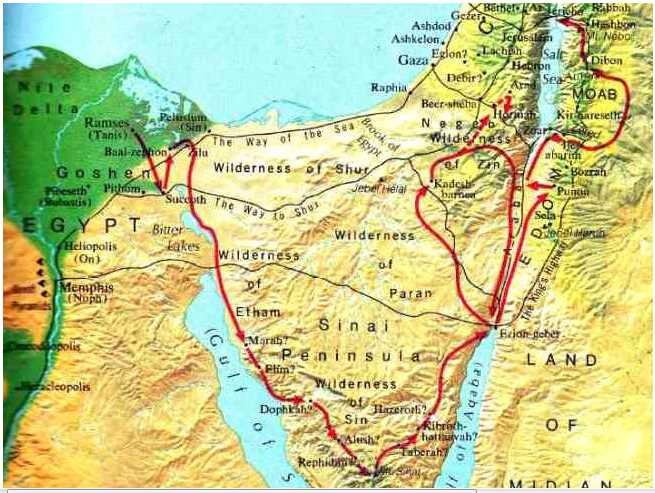
There are actually four mountains located in the southern area that have been proposed as the "mountain of God". Jebal Musa, Jebal Katherine, Jebal Serbal and Jebal Banat. The following map shows the location of other mountains that have been proposed. Jebel Laurz in Arabia, Jebel Bakir near Ezion Geber, Jebel Harun near Petra, Har Karkom south of Kadesh Barnea, Jebel Halal west of Kadesh Barnea, and Jebel Sin Bisher near the Red Sea have all been proposed.
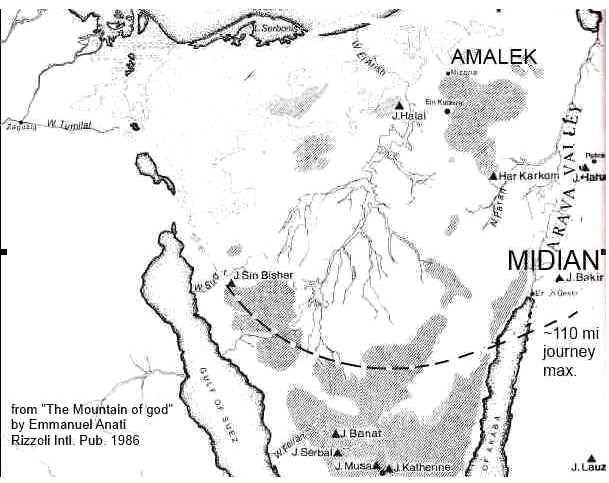
Here are some key verses that may help narrow down the list.
Exo 3:1 Now Moses was keeping the flock of his father-in-law, Jethro, the priest of Midian, and he led his flock to the west side of the wilderness and came to Horeb, the mountain of God.
The mountain must be near or in the territory of Midian, and on its west side!
However, the following passages seem to indicate it was near the route between where Moses's father-in -law lived in Midian and Goshen in Egypt !
Exo 4:19 And the LORD said to Moses in Midian, "Go back to Egypt, for all the men who were seeking your life are dead."Jebel Sin Bisher, Jebel Banat, Jebel Serbal, Jebel Katherine and Jebel Musa all seem to be distant from Midianite territory and any of the major routes from Midian to Goshen. So eliminate them !
Exo 4:20 So Moses took his wife and his sons and had them ride on a donkey, and went back to the land of Egypt. And Moses took the staff of God in his hand. ...
Exo 4:27 The LORD said to Aaron, "Go into the wilderness to meet Moses." So he went and met him at the mountain of God and kissed him.
Exo 4:28 And Moses told Aaron all the words of the LORD with which he had sent him to speak, and all the signs that he had commanded him to do.
Exo 4:29 Then Moses and Aaron went and gathered together all the elders of the people of Israel.
Exo 17:8 Then Amalek came and fought with Israel at Rephidim.Rephidim being the last camp stop before arriving at the "mountain of God". The territory of the Amalekites is described as being just south of Judah and around Kadesh-barnea. Would they have been as far south as Jebel Musa or as far west as Jebel Sin Bisher ? And would they have been into proposed Midian and Edom territory locations of Jebel Bakir, Jebel Harun and Jebel Lauz? It seems unlikely, so eliminate them !
Deu 1:2 It is eleven days' journey from Horeb by the way of Mount Seir to Kadesh-barnea.The Israelites turned a 11 day journey from "Horeb to Kadesh-barnea, where they were near the verge of the promised land; after which they were thirty-eight years wandering up and down in the vicinity of this place, not being permitted, because of their rebellions, to enter into the promised rest, though they were the whole of that time within a few miles of the land of Canaan! (Adam Clarke's Commentary)" Based on observations of Bedouin movements as they graze their herds or flocks of sheep and goats 6 miles per day is a very reasonable estimate ! However, in a Syrian desert it was noted that herders were moving 8-10 miles a day in areas where there was not enough pasture to satisfy the livestock. Therefore, based on conditions of urgency they could have moved between 6 to 10 miles each day ! An eleven day journey distance would seem to eliminate those near to Kadesh-barnea ! And a eleven day journey of 110 miles or less would eliminate all locations to the far south including Jebel Lauz in Arabia !
With the above considerations it would seen to possibly eliminate all of the proposed 10 sites shown on the map above !
Thus it is easy to understand why most archaeologists have given up ! And maybe that is how it should be! Should not the true location of the "mountain of God" be unknown to minimize human desecration ??
However, archaeology is rather limited in what it can actually "prove" ! For a long time archaeologists said Dibon never existed !! Then close examination of the Egyptian records indicated that it did exist !! When three Egyptian lists were combined it showed "... the Biblical story of the invasion of Transjordan that set the stage for the conquest of all Palestine is told against a background that is historically accurate. The Israelite invasion route described in Numbers 33:45b-50 was in fact an official, heavily trafficked Egyptian road through the Transjordan in the Late Bronze Age. And the city of Dibon was in fact on the road in the late Bronze age. ... Ramesses II tells us that he sacked the city in the course of a military campaign in Moab, leaving us with no doubt that Dibon was there at the time, was occupied and was worth sacking." ... ("Exodus Itinerary Confirmed by Egyptian Evidence" by Charles R. Krahmalkov BAR vol 20 Number 5 Sep/Oct 1994) See Appendix B.
Many who have lived in and studied the peninsula know that the northern portion is by far the more hospitable area for surviving in that it has many oases. It abounds in tamarisk bushes, which could have yielded the "manna", and large numbers of quail often overfly the area during migration. Gardening is possible in select areas. The southern portion of the peninsula, however, is not near as hospitable. It was reported by the British governor of the area in the 1930's that as many as 10,000 people lived in the northern area while at the same time only about 2,000 Bedouins managed to live in the southern portion. There is also evidence that in the bronze ages the Egyptians had garrisons in the south to protect the mines they had there, but that there was no Egyptian presence in the northern portion so that the Israelite nomads would have not encountered any of the Egyptian army in the northern section of the peninsula.
Exo 13:4 Today, in the month of Abib, you are going out.So they knew where they were going and they were not to go by the Way of the Sea, thus the second route was through the Wilderness of Shur !! The Wilderness of Shur and the Way to Shur is designated on the first map above and the route goes near to Jebel Halal, one of the proposed locations, and also near to Kadesh-barnea. But the skeptics maintain Jebel Halal is only 2 days journey from Kadesh-barnea . So maybe it would be wise to look for another location in the wilderness of Shur, closer to Egypt so that Aaron did not have to travel very far from Egypt to meet with Moses !! There are shown on the relief map mountain ranges between the wilderness of Shur and the Wilderness of Paran maybe about half way between Goshen and Kadesh-barnea !! (Appendix C shows aerial photo of Kadesh.)
Exo 13:5 And when the LORD brings you into the land of the Canaanites, the Hittites, the Amorites, the Hivites, and the Jebusites, which he swore to your fathers to give you, a land flowing with milk and honey, you shall keep this service in this month. ...
Exo 13:17 When Pharaoh let the people go, God did not lead them by way of the land of the Philistines, although that was near. For God said, "Lest the people change their minds when they see war and return to Egypt."
Exo 13:18 But God led the people around by the way of the wilderness toward the Red Sea. And the people of Israel went up out of the land of Egypt equipped for battle. ...
Exo 15:22 Then Moses made Israel set out from the Red Sea, and they went into the wilderness of Shur. They went three days in the wilderness and found no water.
Assuming the route of travel approximated the Way of Shur and/or the route through the Jidda Pass and then by Bir Hassane, eleven days of travel from Kadesh-barnea at a rate of 6 to 10 miles per day would realistically place the location somewhere within the blue circle placed on the map below. Note that the direct route from Midian to Goshen passes through the south of this area as we have traced along it in yellow. Thus when "Moses took his wife and his sons and had them ride on a donkey, and went back to the land of Egypt." (Exodus 4:20), the direct route would have taken him close by the groups of mountains in this area ! A short and direct travel path for each to the meeting between Aaron and Moses; " Go into the wilderness to meet Moses." So he went and met him at the mountain of God "(Exodus 4:27) !!
Also this area is only a few days travel along the Way of Shur for a band of Amalekite warriors for the battle at Rephidim;"Then Amalek came and fought with Israel at Rephidim (Exodus 17:8)
Thus we have roughly traced in red possible routes from Goshen to Kadesh-barnea on the map below !!
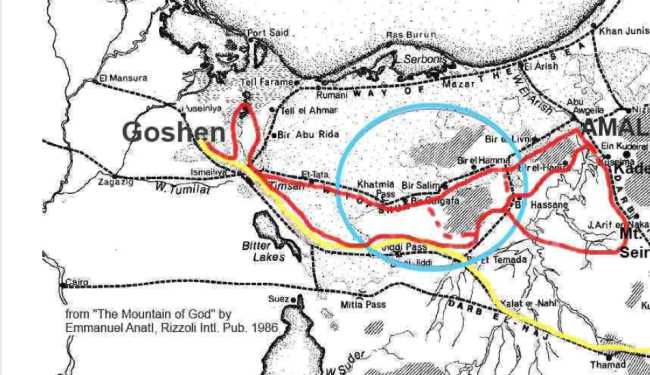
Summary: We have listed Scripture passages that when properly considered would seem to eliminate 10 of the better known proposed locations for the mountain of God during the Exodus. And have instead proposed an area through which the Way of Shur passes and another major route just to the south as the area in which the mountain of God was mostly likely located. An area that is within eleven days travel for a large group of people with "very much livestock, both flocks and herds." (Exo 12:38) from Kadesh-barnea . The route of the Exodus most likely being partially along the same route that Moses used to return to Egypt after his 40 year stay in Midian.
However, we believe that it is best if the actual location of the mountain of God remains a mystery !
Appendix A
Details of the beginning phase of the Exodus as proposed by the Associates for Biblical Research
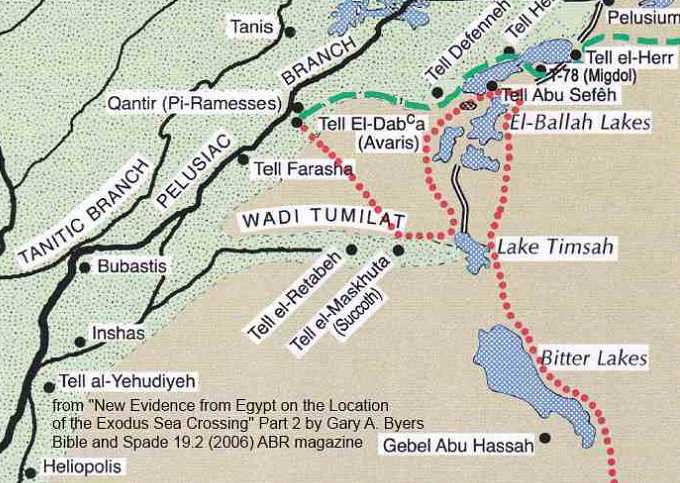
The Parting of the Sea of Reeds
Exo 14:21 Then Moses stretched out his hand over the sea, and the LORD drove the sea back by a strong east wind all night and made the sea dry land, and the waters were divided.The phenomenon of wind setdown occurs in shallow coastal areas when strong winds blow offshore. When wind stress acts for several hours on a body of water, the free water surface acquires a low-angle tilt. This tilt causes the water on the upwind side to recede from the original shoreline, leaving exposed mud flats on the bottom. Wind setdown is opposite to storm surge and comparable in vertical displacement, although wind setdown is less well known because it usually poses no danger to lives and property. Wind setdown events on the order of 2 meters were recorded by measuring stations at the western end of Lake Erie on December 12, 2006, and January 3031, 2008
Exo 14:22 And the people of Israel went into the midst of the sea on dry ground, the waters being a wall to them on their right hand and on their left.
Computer simulations by Carl Drews of UCAR ( University Corporation for Atmospheric Research) show that a strong east wind, blowing overnight, could have pushed water back at a bend where a river merges with a coastal lagoon along the sea. With the water pushed back into both waterways, a land bridge would have opened at the bend, enabling people to walk across exposed mud flats. As soon as the wind died down, the waters would have rushed back in. The simulations showed that a wind of 63 miles an hour, lasting for 12 hours, would have pushed back waters estimated to be six feet deep. This would have exposed mud flats for four hours, creating a dry passage.
(The technical article "Dynamics of Wind Setdown at Suez and the Eastern Nile Delta" is at http://www.plosone.org/article/info%3Adoi%2F10.1371%2Fjournal.pone.0012481)
Extracts from "Exodus Itinerary Confirmed by Egyptian Evidences"
by Charles R. Krahmalkov from Biblical Archaeology Review
vol 20 Number 5 Sep/Oct 1994,
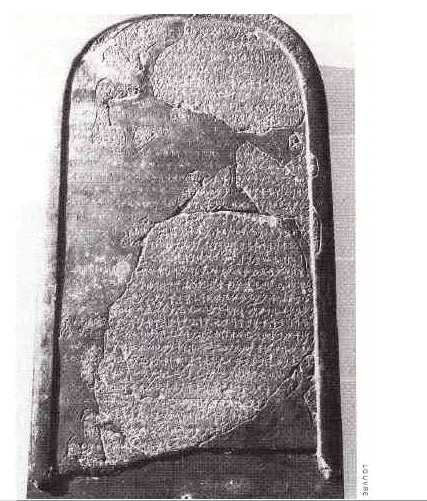
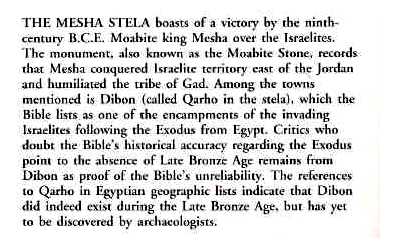
The Egyptian records include lists from the reigns of
a) Ramesses II (c. 1279-1212 B.C.E.),
b) Amenophis III (c. 1387-1350 B.C.E.),
c) Thutmosis III (c. 1504-1450 B.C.E.)
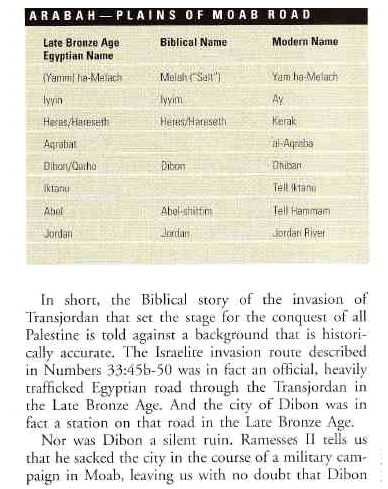

Appendix C Aerial photo of Kadesh.
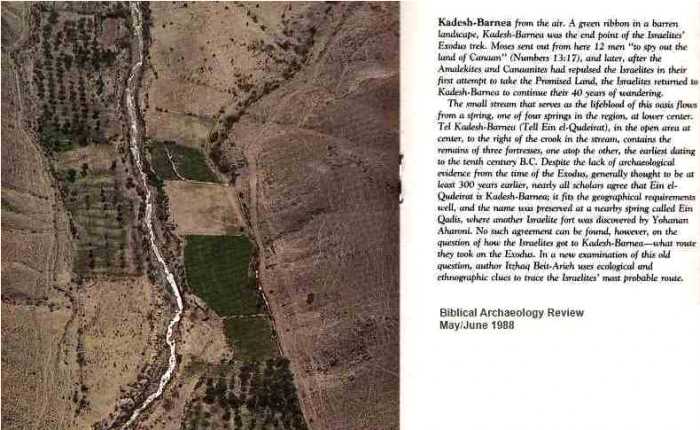
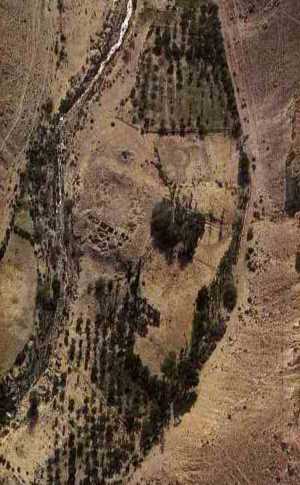
Chapter 3
Were the Israelites in Egypt for 210 years or 430 years ??
The case for 210 years is presented in John Gill's Exposition of the Entire Bible: "Exo 12:40
Now the sojourning of the children of Israel, who dwelt in Egypt,.... The Septuagint version adds, "and in the land of Canaan"; and the Samaritan version is,"the sojourning of the children of Israel, and of their fathers, in the land of Canaan, and in the land of Egypt.''Agreeably to which are both the Talmuds: in one (o) of them the words are,"in Egypt and in all lands,''and in the other (p),"in Egypt, and in the rest of the lands;''and in the same way Aben Ezra interprets the words. And certain it is, that Israel did not dwell in Egypt four hundred and thirty years, and even not much more than two hundred years; but then they and their fathers, Abraham, Isaac, and Jacob, dwelt so long in Mesopotamia, in Canaan, and in Egypt, in foreign countries, in a land not theirs, as the phrase is, Gen_15:13 where the place of their sojourning, and the time of it, are given by way of prophecy. The Jews reckon from the vision of God to Abraham between the pieces to the birth of Isaac thirty years, so the Targum of Jonathan; but that cannot be, though from his coming out of his own native place, Ur of the Chaldeans, to the birth of Isaac, might be so many years, since he was seventy five years of age when he came out of Haran, Gen_12:4 and if he stayed at Haran five years, as probably he did, then there were just thirty from his coming out of Ur of the Chaldees to Isaac's birth, since he was born when he was one hundred years old; and from the birth of Isaac to the birth of Jacob was sixty years, Gen_25:26 and from thence to his going down to Egypt was one hundred and thirty, Gen_47:9 and from thence to the coming of Israel out of Egypt were two hundred and ten years, as is generally computed, which make the exact sum of four hundred and thirty years;"
The case for 430 years is presented by Keil and Delitzsch Commentary on the Old Testament: "Exodus 12:40-41
The sojourn of the Israelites in Egypt had lasted 430 years. This number is not critically doubtful, nor are the 430 years to be reduced to 215 or 210 by an arbitrary interpolation, such as we find in the lxx, This chronological statement, the genuineness of which is placed beyond all doubt by Onkelos, the Syriac, Vulgate, and other versions, is not only in harmony with the prediction in Gen_15:13, where the round number 400 is employed in prophetic style, but may be reconciled with the different genealogical lists, if we only bear in mind that the genealogies do not always contain a complete enumeration of all the separate links, but very frequently intermediate links of little historical importance are omitted, as we have already seen in the genealogy of Moses and Aaron (Exo_6:18-20). For example, the fact that there were more than the four generations mentioned in Exo_6:16. between Levi and Moses, is placed beyond all doubt, not only by what has been adduced at Exo_6:18-20, but by a comparison with other genealogies also. Thus, in Num_26:29., Exo_27:1; Jos_17:3, we find six generations from Joseph to Zelophehad; in Rth_4:18., 1Ch_2:5-6, there are also six from Judah to Nahshon, the tribe prince in the time of Moses; in 1Ch_2:18 there are seven from Judah to Bezaleel, the builder of the tabernacle; and in 1Ch_7:20., nine or ten are given from Joseph to Joshua. This last genealogy shows most clearly the impossibility of the view founded upon the Alexandrian version, that the sojourn of the Israelites in Egypt lasted only 215 years or 210; for ten generations, reckoned at 40 years each, harmonize very well with 430 years, but certainly not with 215 or 210.
(Note: The Alexandrian translators have arbitrarily altered the text to suit the genealogy of Moses in Exo_6:16., just as in the genealogies of the patriarchs in Gen 5 and 11. The view held by the Seventy became traditional in the synagogue, ... )
The statement in Exo_12:41, the self-same day, is not to be understood as relating to the first day after the lapse of the 430 years, as though the writer supposed that it was on the 14th Abib that Jacob entered Egypt 430 years before, but points back to the day of the exodus, mentioned in Exo_12:14, as compared with Exo_12:11., i.e., the 15th Abib (cf. Exo_12:51 and Exo_13:4). "
However, the Genesis 15:13-16 prophecy seems to definitely resolve the discussion, there being no record that Abraham was ever a servant or afflicted and he died in peace per 15:15 !
Gen 15:13 Then the LORD said to Abram, "Know for certain that your offspring will be sojourners in a land that is not theirs and will be servants there, and they will be afflicted for four hundred years.It is NOT said "the land" Abraham was then in which they were then strangers, though God did judge, condemn, and punish the inhabitants of the land of Canaan due to their iniquity, and drove them out of it, to make way for Israel; but the "the nation that they serve", meaning the Egyptians, to whom they became slaves, and were very hard and severely used by them; those the Lord threatens to enter into judgment with, and take vengeance upon them, as he did by inflicting the ten plagues on them, which brought Pharaoh to at last be willing to let Israel go with very rich spoil. " Exo 12:36 And the LORD had given the people favor in the sight of the Egyptians, so that they let them have what they asked. Thus they plundered the Egyptians." After they had been in Egypt more than 400 years!
Gen 15:14 But I will bring judgment on the nation that they serve, and afterward they shall come out with great possessions.
Gen 15:15 As for yourself, you shall go to your fathers in peace; you shall be buried in a good old age.
Gen 15:16 And they shall come back here in the fourth generation, for the iniquity of the Amorites is not yet complete." ( A generation, or a revolution of time, or an age, being in this case 100 years.)Also repeated in:
Act 7:6 And God spoke to this effect--that his offspring would be sojourners in a land belonging to others, who would enslave them and afflict them four hundred years.
Act 7:7 'But I will judge the nation that they serve,' said God, 'and after that they shall come out and worship me in this place.'
Many refer to:
Gal 3:16 Now the promises were made to Abraham and to his offspring. It does not say, "And to offsprings," referring to many, but referring to one, "And to your offspring," who is Christ.
Gal 3:17 This is what I mean: the law, which came 430 years afterward, does not annul a covenant previously ratified by God, so as to make the promise void.
NOT that the 430 years was from when the promise was first made to Abraham, but the promise was affirmed to Jacob in Genesis 46:1-6 to not be afraid to go down into Egypt, that he would be made into a great nation, and this becomes the starting of the 430 years !
Gen 46:1 So Israel took his journey with all that he had and came to Beersheba, and offered sacrifices to the God of his father Isaac.
Gen 46:2 And God spoke to Israel in visions of the night and said, "Jacob, Jacob." And he said, "Here am I."
Gen 46:3 Then he said, "I am God, the God of your father. Do not be afraid to go down to Egypt, for there I will make you into a great nation.
Gen 46:4 I myself will go down with you to Egypt, and I will also bring you up again, and Joseph's hand shall close your eyes."
Gen 46:5 Then Jacob set out from Beersheba. The sons of Israel carried Jacob their father, their little ones, and their wives, in the wagons that Pharaoh had sent to carry him.
Gen 46:6 They also took their livestock and their goods, which they had gained in the land of Canaan, and came into Egypt, Jacob and all his offspring with him,
Gen 46:7 his sons, and his sons' sons with him, his daughters, and his sons' daughters. All his offspring he brought with him into Egypt.
The 430 total years being from 1876 BC until 1446 BC !! (The Bible Knowledge Commentary on the Old Testament, page 129)
The Pharaoh of the Exodus ?
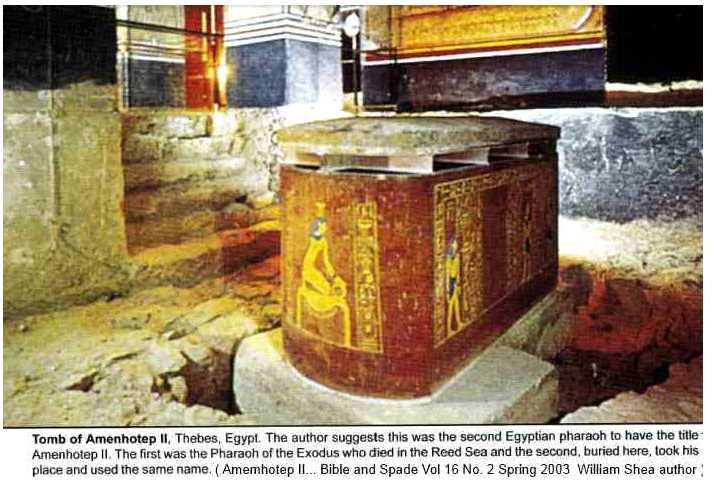 Amenhoptep II having assumed reign in 1450 BC and it is documented that his "first military campaign" was in 1447. But then there was a second "first military campaign" documented in 1445 BC !! This discrepancy and others has lead William Shea to propose that the first Amenhoptep II, who he calls Amenhoptep IIA, perished during the Sea of Reeds crossing and a second man, possibly a brother, became Pharaoh using the same name, and this Amenhoptep IIB finished the reign. There is even an unidentified mummy that could be Amenhoptep IIA, Pharaoh of the Exodus, which was not preserved in the normal way. The body being that of a male in his early twenties, as would be the Pharaoh of the Exodus in 1446 BC if he was Amenhoptep IIA who perished then !!
Amenhoptep II having assumed reign in 1450 BC and it is documented that his "first military campaign" was in 1447. But then there was a second "first military campaign" documented in 1445 BC !! This discrepancy and others has lead William Shea to propose that the first Amenhoptep II, who he calls Amenhoptep IIA, perished during the Sea of Reeds crossing and a second man, possibly a brother, became Pharaoh using the same name, and this Amenhoptep IIB finished the reign. There is even an unidentified mummy that could be Amenhoptep IIA, Pharaoh of the Exodus, which was not preserved in the normal way. The body being that of a male in his early twenties, as would be the Pharaoh of the Exodus in 1446 BC if he was Amenhoptep IIA who perished then !!
Where did Moses and Aaron as the representatives of God and Pharaoh battle it out ?
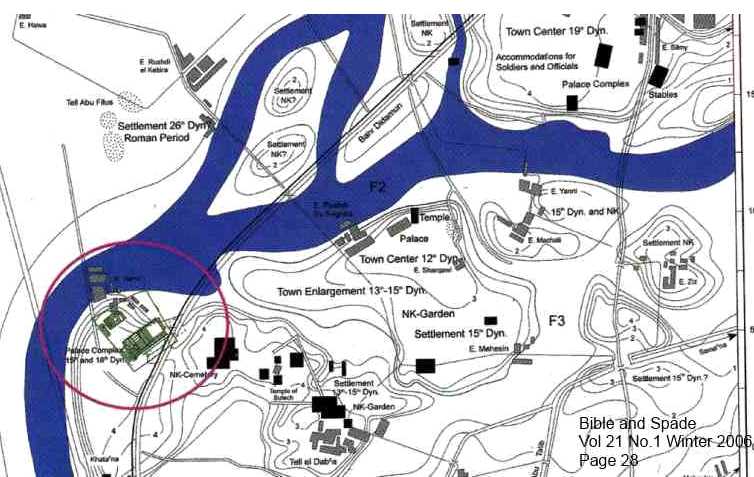 Above is a diagram of the located palace complexes at "Perunefer" ("happy journey"), later called Rameses. Also called "Rowaty" ("the door of the two roads") at the time that Jacob and family arrived. Complexes from the 12th to the 19th dynasty ( about 1991BC to 1185 BC ) have been located. The red circled area is the palace complex where Moses and Pharaoh would have met during the 18th dynasty. Probably established by Tuthmosis I (1524-1518 BC) and abandoned during the reign of Amenhotep II. It was constructed of unfired clay bricks with doorways and columns of limestone. At the base of the ramps to each of the palaces were found remaining piles of "Minoan" type frescoes. There is no obvious reason why the complex was abandoned, except possibly the result of the plagues ?
Even though the Israelites had multiplied greatly in 430 years, they still resided in Goshen just to the east of Rameses!!
Exo 8:22 But on that day I will set apart the land of Goshen, where my people dwell, so that no swarms of flies shall be there, that you may know that I am the LORD in the midst of the earth.
Exo 9:26 Only in the land of Goshen, where the people of Israel were, was there no hail.
Above is a diagram of the located palace complexes at "Perunefer" ("happy journey"), later called Rameses. Also called "Rowaty" ("the door of the two roads") at the time that Jacob and family arrived. Complexes from the 12th to the 19th dynasty ( about 1991BC to 1185 BC ) have been located. The red circled area is the palace complex where Moses and Pharaoh would have met during the 18th dynasty. Probably established by Tuthmosis I (1524-1518 BC) and abandoned during the reign of Amenhotep II. It was constructed of unfired clay bricks with doorways and columns of limestone. At the base of the ramps to each of the palaces were found remaining piles of "Minoan" type frescoes. There is no obvious reason why the complex was abandoned, except possibly the result of the plagues ?
Even though the Israelites had multiplied greatly in 430 years, they still resided in Goshen just to the east of Rameses!!
Exo 8:22 But on that day I will set apart the land of Goshen, where my people dwell, so that no swarms of flies shall be there, that you may know that I am the LORD in the midst of the earth.
Exo 9:26 Only in the land of Goshen, where the people of Israel were, was there no hail.
Summary: The 430 total years of the sojourn of the Israelites in Egypt was from 1876 BC until 1446 BC !!
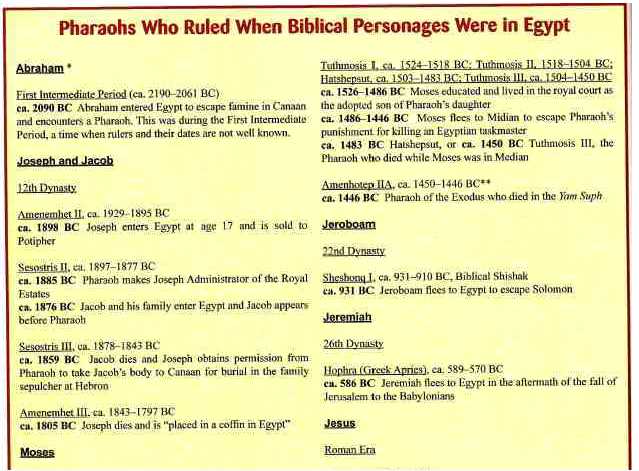
-.
